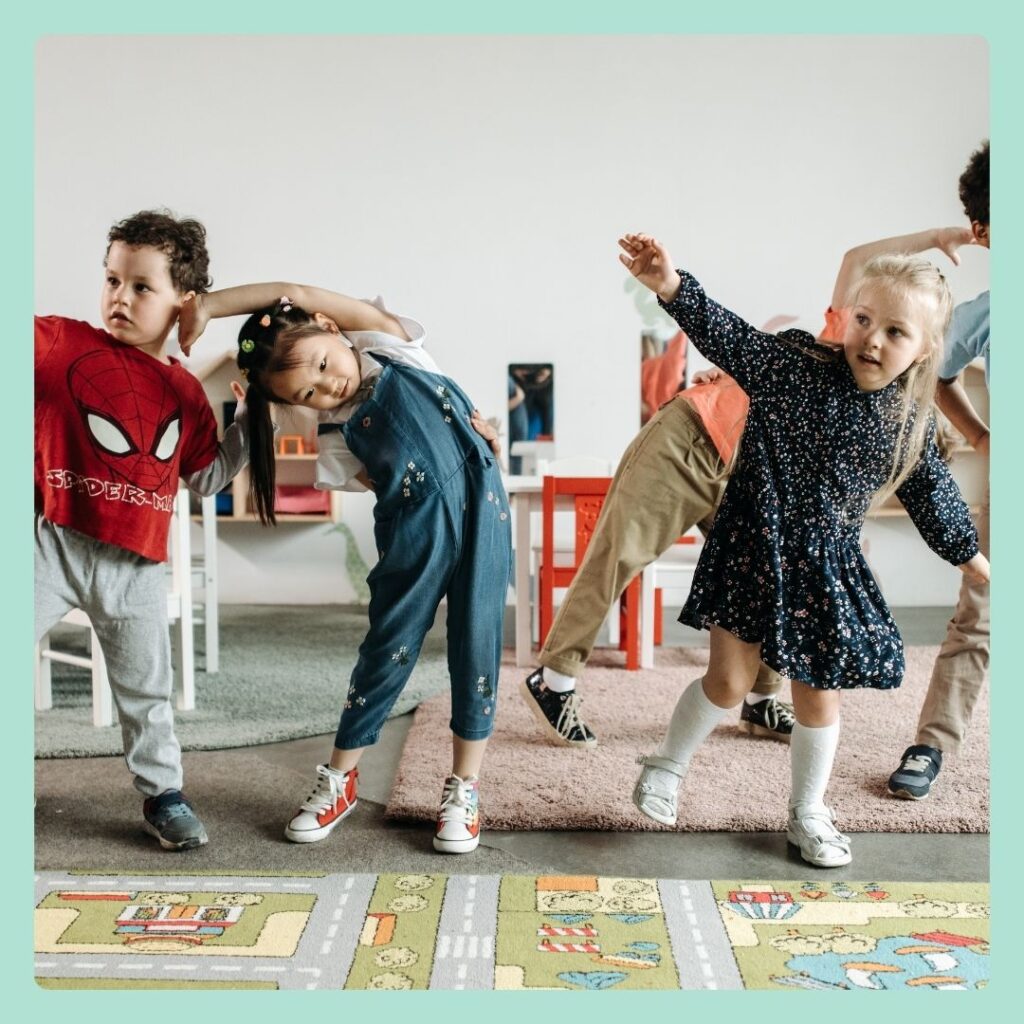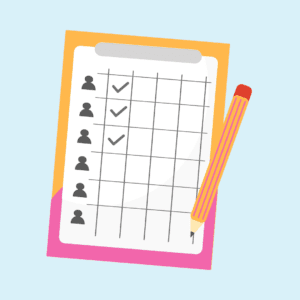If you find yourself reaching for worksheets for classroom guidance lessons and you’re noticing that students are lacking interest or engagement, it’s time to ditch the desks! Getting your students moving to learn and practice the skills you’re targeting in counseling instruction will boost engagement and have your students begging for more classroom guidance time. Sometimes when we think of movement-based activities in counseling, we get hung up on calming movements like yoga. But there are so many other ways we can get our students moving! Keep reading to find ideas to get your students moving during counseling lessons and some simple materials that can be used to create a variety of activities.
Benefits of Movement in the Classroom
The subject of movement in the classroom has been a hot topic in recent years. Research has found that students show greater interest in classroom subjects when they are moving while learning compared to their stationary peers. By allowing students to move while they learn, we encourage them to build personal, meaningful connections to the curriculum that are harder to develop while glued to a seat with a worksheet.
Desk-Free Activities You Can Try This Year
Escape Rooms
Escape room activities are popping up for all academic subjects, and there’s lots of room for counseling topics as well. If you’re unfamiliar with escape rooms, students are essentially working cooperatively to “escape” from some situation that you’ve created by solving puzzles around your topic.
For example, in an empathy escape room, the situation might be: Oh no! You’re stuck in the self-involved spiral and things are getting lonely! You’ll have to use your empathy skills to escape the spiral and grow your understanding of the people around you.
Students will then work together to solve empathy-themed puzzles in order to move through your “escape room” and reach some kind of ultimate final puzzle. They will have to use conversational skills, critical thinking skills, and cooperation skills in order to be successful!
Interest Walk
Why sit when you can move? I have definitely used paper and pencil career interest assessments in the past because sometimes they’re just convenient in a time-limited situation. But one of my favorite career interest assessment activities is a career walk.
Using your projector or interactive whiteboard, show statements with multiple responses. Each response will be representative of a different career cluster. Students will choose the response that is most true for them and walk to a specific area of the room and collect a card with a color that represents that same career cluster.
For example, if you’re using the 6-cluster model, you will have 6 areas in your room each represented by a different color. Students will see this statement: A goal I want to accomplish in a career is… (blue) form meaningful relationships with people, (purple) perform in front of others, (yellow) create my own company, (green) protect and care for animals, (orange) create products that solve problems, (red) help sick people feel better.
Each response for each statement or question represents a different career cluster. For each statement, students will collect one color card that best matches their interests or preferences. At the end of the activity, students will see which color they collected the most and then gather in small groups to learn more about careers in those clusters.
So students are still completing a career interest assessment, but they are moving around the room to do it! It’s a really simple way to get your students moving while they’re learning.
4 Corners
Another take on an interest walk is 4 corners. This is adaptable to just about any kind of question and response activity. Students all begin in the middle of the room and the counselor will read a statement. Students will then walk to the corner that best represents their answer or response to the statement.
For example, in a lesson on bullying, “Someone has called me a mean name repeatedly after I asked them to stop.” Students might walk to one of 4 areas that say, “This has happened to me,” “This has happened to someone I care about,” “I have done this to someone,” or “I’ve never seen this happen.”
This is just a way to get your students moving, responding, and observing as they do a movement-based assessment. They can see how their peers are responding and start to form reactions and responses about school climate or whatever you are attempting to measure with your activity. They may also find common ground with peers that they wouldn’t necessarily notice from a traditional pencil and paper assessment.
With younger students, use 4 corners to help practice identifying emotions, facial expressions, or feelings behind a statement. Label your corners with colors or emotion words. Then, show your students pictures or read statements and let them walk to the corner that best represents the emotion shown.
Back-Spin
Back-Spin is an activity I created for a particularly high energy class that really loved to move. Highly structured activities just weren’t a good fit for them, so I braved the chaos with this activity.
In Back-Spin, each student has a task card or question taped to his or her back. Each student also has a handout with spaces numbered for each task card or question. Students stand on labeled spots on the floor in a circle. Every student turns to the left, reads the task card on his neighbor’s back, and responds on the handout. Students then all spin around 180 degrees and face the other direction. They then respond to the task card on that neighbor’s back. Then, students move to a new space in the circle, standing beside 2 new neighbors. Everyone turns to the left again, continuing to respond to task cards in this manner.
For example, in a test-taking skills back-spin activity, task cards will have questions about eliminating wrong answers, underling important words, and quick and effective brain breaks.
As you can imagine, this can get chaotic without clear expectations. It’s really important to set expectations about how students will move about the circle so that everyone is safe while still having fun. Of course, sometimes students end up beside neighbors they’ve already been beside, but it’s okay. They can review the question again and try to see it from a different point of view.
If you have a high energy group of students, you might find that letting them move more, and being okay with a little bit of chaos mixed with clear expectations, works well to keep then actually engaged and on task. Letting them use that energy will be more effective than trying to squash it!
Musical Chairs
Students across grade levels love musical chairs! It’s another activity that’s really easy to adapt to any topic or lesson. Simply put your chairs in a circle and label 1-2 chairs. Students will move around the circle as music plays and then sit when the music stops. The student(s) in the marked chairs when the music stops will answer a question or perform a given task. I’ve used this set up to practice identifying emotions, practice making I feel statements, identifying healthy choices, and more. It’s always a crowd-pleaser and everyone gets to move!

Easily Adaptable Supplies for Desk-Free Activities
If you’re wanting to incorporate more movement into your lessons, and aren’t sure where to start, consider grabbing some of these easily adaptable supplies: cones, rings, buckets, stress balls, and balloons.
Cones & Rings:
Cones and rings can turn an activity on any topic into a fun game! For an activity on expressing emotions, label your cones with feeling faces or words. Students can toss a ring and then make an “I feel” statement using the emotion pictured on the cone on which their ring lands.
If you have colored cones, you can designate any type of response to a given color. For example, if your ring lands on red, tell us a calming strategy you use when you feel angry. If your ring lands in blue, tell us a positive self-talk statement you use when you’re feeling sad.
Buckets & Stress Balls
Buckets can be used as basketball hoops or for relays along with your stress balls. As a review activity, you can have a student name effective calming strategies while tossing a ball into the bucket. The student can keep naming strategies until he or she makes a basket and then move to the back of the line. Challenge your students to name a certain number of strategies in a time limit to really get them moving quickly and thinking on their feet.
For a team-building relay, divide students into teams and give each team a bucket. Two members from each team can link arms back to back and walk to a specific area and answer a question together about the topic you’re teaching. If they give a correct answer, give the students a ball to carry together back to the bucket. The team with the most balls in their buckets at the end of the activity wins!
Balloons
Divide your students into two teams for a game of balloon volleyball. Challenge each team to call out a response each time they tap the balloon. If you’re covering careers, have students call out community helpers in the agricultural sciences career cluster. If you’re covering calming strategies, have students call out calming strategies each time they tap the balloon. This is another really simple activity that is really adaptable to a variety of topics!
For a fun twist on a task card activity, number a balloon for each task card you have. Students will stand in a circle and tap balloons (gently) back and forth while music plays. When the music stops, each student will grab a balloon. Call a number, and the student with that balloon will respond to the task card. This is a really easy way to get students out of their seats for a fun spin on an everyday activity.
Make Your Plan
As you begin planning your lessons for the year, look for new ways to incorporate movement. Think of an activity that you typically do with your students that involves worksheets or sitting. Then find some everyday items that can transform your desk-bound activity into a movement-focused exercise. Take note of how your students respond – we think you’ll be happy with what you see in terms of engagement and retention!
Be sure to let us know about your favorite way to get students moving during counseling lessons in the comments section below!
Check out this other post about Cooperative Activities for School Counseling Lessons.










I love this!
Thanks, Lindsey!!
[…] themselves with more lax rules than within the classroom. Fun, engaging, dynamic lessons (like Counselor Keri’s movement based lessons) or activities that allow a student to express themselves through art, are a great way to get […]